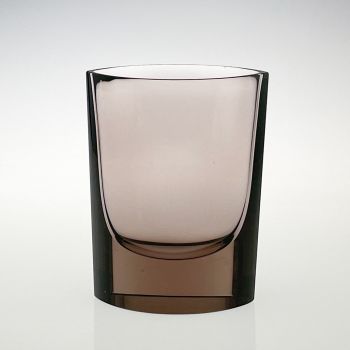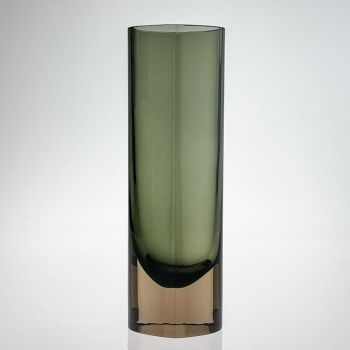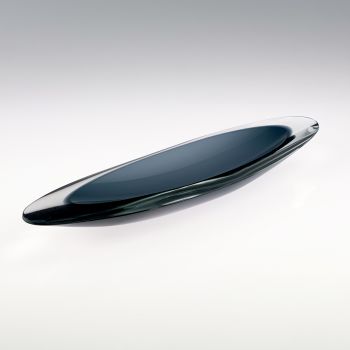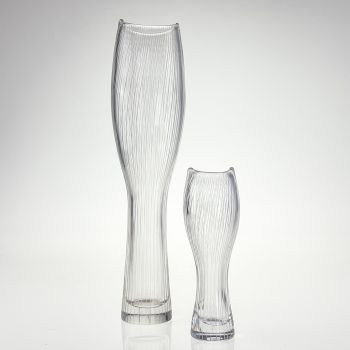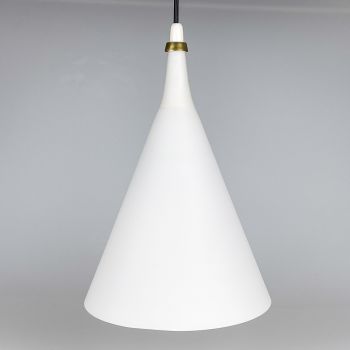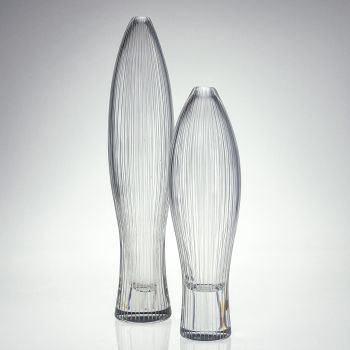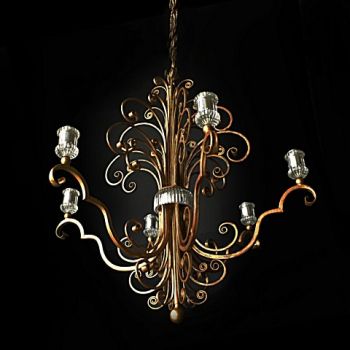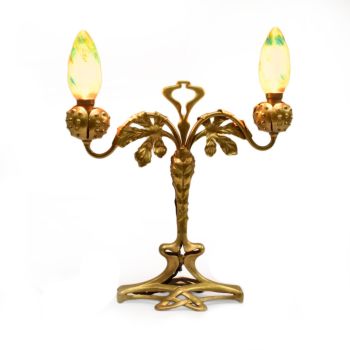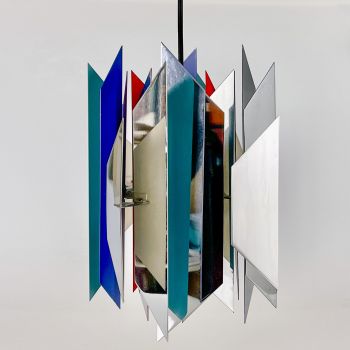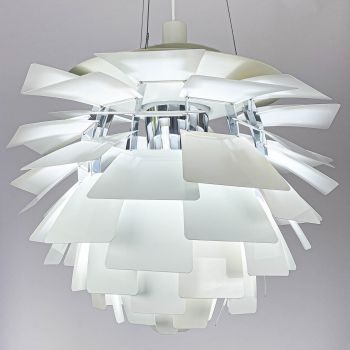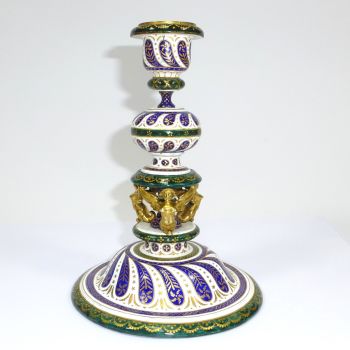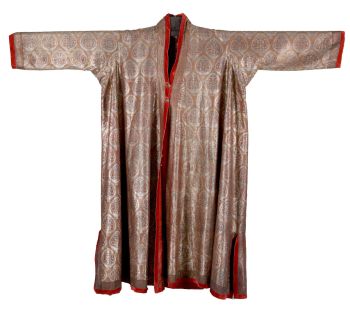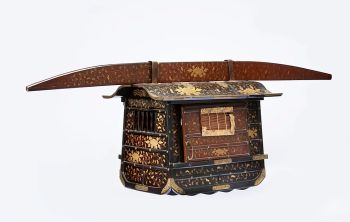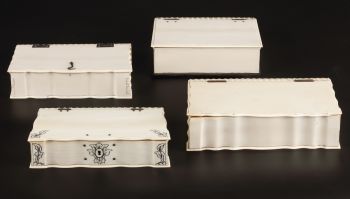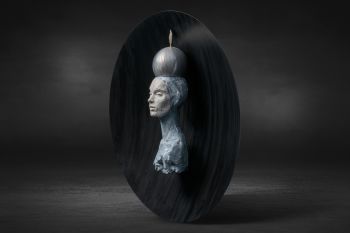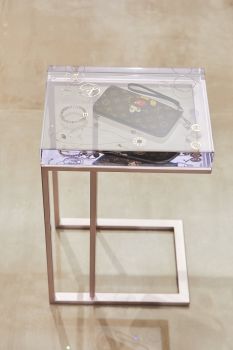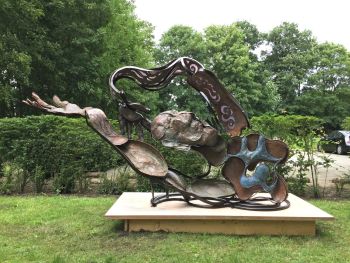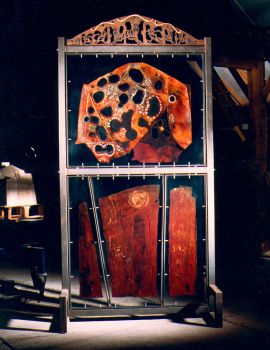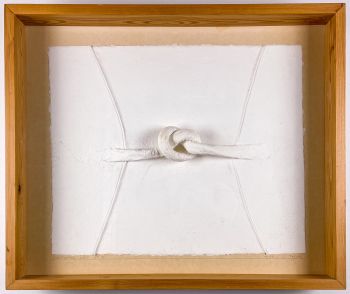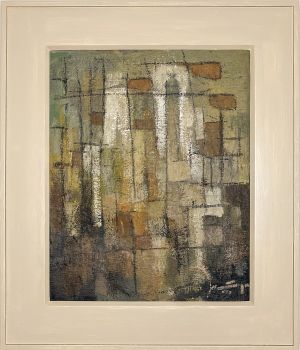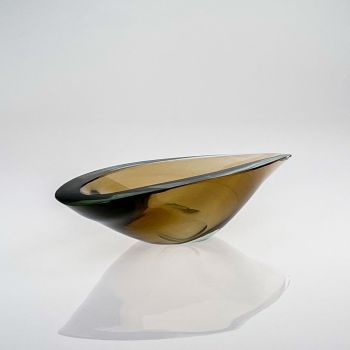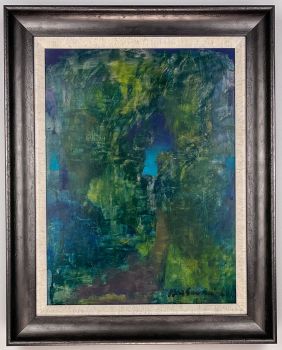Desk lamp, model 9227 – Idman, Finland ca 1955 1950 - 1960
Paavo Tynell
AluminiumSteelMetalBrass
45 ⨯ 23 ⨯ 23 cm
ConditionVery good
€ 2.450
Van Kerkhoff Art
- About the artworkA painted aluminium, brass and steel adjustable desk lamp with perforated shade, model 9227. Designed by the renowned Finnish lighting designer Paavo Tynell in the 1940’s and made by Idman Oy, Helsinki circa 1955.
The desk lamp has a round lacquered steel base. A brass rod is mounted on the base to which the lacquered perforated aluminium shade is connected. This connection is quite eleganty designed with a brass wing nut and is stamped “Idman Oy” in graceful lettering.
This desk lamp is in excellent condition, recently restored in it’s original condition.
About Paavo Tynell
Paavo Tynell (1890-1973) saw the light of day in Helsinki, twelve years after the introduction of the light bulb, at a time when Finland and most of northern Europe were still in the process of electrification. His birth marked the beginning of his journey to become a leading pioneer of modern lighting, in parallel with the spread of electric light around the world. By the year of his death in 1973, Tynell was entrenched as ‘the man who enlightened Finland’.
In his early years, it seemed unlikely that Tynell would become one of the most influential designers of his time. He was the seventh of nine children in a working-class family that could not afford further education for him after primary school. At the age of 16 he began his apprenticeship at G.M. Sohlberg’s metal workshop, where he worked as a sheet metal worker for six years before becoming a blacksmith for another year. During these formative years, Tynell created his first lamp fixturemade of brass, which would later become his signature material.
In 1918, together with his former teacher Ehrström, Tynell founded metal smith Frans Nykänen, sculptor Emil Wickström and industrialist
Gösta Serlachius the company Taito Oy. As managing director, Tynell led the production of various lighting fixtures, functional metal objects, sculptures and custom-made designs from the foundry of the company.
During the 1920s, Tynell was the principal designer at Taito, assisted by other talented designers and artists such as Alvar Aalto, Henry Ericsson and Ville Vallgren. By the 1930s Taito concentrated exclusively on lighting and played a crucial role in the growing electrification of independent Finland.
Internationally, Tynell enjoyed fame, with notable projects such as the lighting of the Parliament building in Helsinki, designed by architect Johan Sigfrid Sirén, and collaborations with leading modernist architects, notably Alvar Aalto.
The 1930s and 1940s were a period of experimentation for Tynell. His design style evolved from functionalist and art deco designs to more decorative and elegant expressions. During this time, he served as president of Ornamo, the Finnish association of industrial designers, where he supported and trained young designers. His influence extended extended beyond Finland, especially in the United States, where he almost
became a celebrity.
After World War II, Tynell returned to brass as his signature material, creating unique lamps that combined traditional aesthetics with a modern look.
Brass quickly became the signature of Taito, which now had about 150 employees. From the 1930s to the 1950s, Tynell was considered as Finland’s leading lighting designer and he was frequently asked to illuminate public spaces across the country,
particularly in Helsinki, where his lighting is still an integral part of the city structure.
His influence also extended internationally, especially in the US, where he achieved great success as a designer achieved great success. Taito’s merger with the lighting factory Idman Oy in 1953 led to Tynell’s retirement as director, but he continued to design for Taito and other lighting brands in Finland and abroad. His collaboration with the respected brand Lightolier in the US continued until 1966. Tynell’s legacy continues to shine, not only in Finland, but worldwide, as an icon of innovation in the world of lighting design.
Marked
Stamped Idman Oy
Execution
Idman Oy, Helsinki ca 1955
Condition
Very good condition. Complete restoration. Rewired. Wear consistent with age and use.
Literature
Ville Linna, Chasing Light: The Archival Photographs and Drawings of
Paavo Tynell
Charlotte and Peter Fiell, eds., 1000 Lights, Vol. 1: 1879 to 1959, p. 399
Dimensions
Height 45 cm
Width 23 cm
Depth 23 cm - About the artist
Paavo Tynell (1890–1973) was a Finnish industrial designer and master craftsman, celebrated for his innovative lighting designs that blended functionality with artistic elegance. Known as "the man who illuminated Finland," Tynell played a pivotal role in shaping mid-century modern lighting design. His works, characterized by their whimsical yet sophisticated forms, are now iconic symbols of Scandinavian design.
Paavo Tynell was born on January 25, 1890, in Helsinki, Finland. He began his career as a metalsmith apprentice before enrolling at the Helsinki University of Industrial Arts (now Aalto University). His training as a metal artisan profoundly influenced his design approach, giving him a deep understanding of materials and craftsmanship.
In 1918, Tynell co-founded Oy Taito Ab, a company that specialized in high-quality metalwork and lighting design. Under his leadership as chief designer, Taito became one of Finland's most renowned lighting manufacturers. His early designs often featured intricate metalwork and detailed craftsmanship, reflecting his background as a smith.
Tynell's breakthrough came in the 1930s and 1940s, when he began integrating modernist principles into his work. Drawing inspiration from nature, he crafted lighting fixtures with graceful, organic forms, such as perforated brass shades, delicate floral motifs, and airy, sculptural elements. His work often combined brass, glass, and fabric to create pieces that were both functional and visually enchanting.
Collaborating with architects such as Alvar Aalto and interior designer Aino Aalto, Tynell contributed to many significant projects, including public buildings, hotels, and private residences in Finland and abroad. His designs for the Finnish Parliament House and the Savoy Hotel in Helsinki are particularly noteworthy.
Tynell’s work gained international acclaim during the mid-20th century. In the United States, his designs were distributed by Lightolier, bringing his signature blend of Nordic craftsmanship and artistry to a global audience. His pieces became highly sought after for their elegance and versatility, often used in high-profile interiors.
Paavo Tynell retired in the 1950s, but his influence on lighting design endured. His work was rediscovered in the 21st century, with original Tynell lamps fetching high prices at auctions and inspiring a new generation of designers. Contemporary brands, such as GUBI, have reissued some of his most iconic designs, ensuring his legacy continues.
Paavo Tynell passed away on September 13, 1973, in Helsinki, leaving behind a body of work that exemplifies the harmonious blend of art, craft, and functionality. His timeless designs remain a testament to the beauty of Finnish modernism and its enduring appeal in contemporary interiors.
Are you interested in buying this artwork?
Artwork details
Related artworks
Børge Mogensen
Teak wood “dropleaf” desk – Søborg Møbler, Denmark circa 19551950 - 1960
Price on requestVan Kerkhoff Art
1 - 4 / 24Unknown artist
A JAPANESE MODEL OF A NORIMONO, A PALANQUIN1650 - 1700
Price on requestZebregs & Röell - Fine Art - Antiques
Unknown artist
A Dutch colonial Indonesian betel box with gold mounts1750 - 1800
Price on requestZebregs & Röell - Fine Art - Antiques
Unknown artist
A COLLECTION OF FOUR SRI LANKAN IVORY BIBLE BOXES18th century
Price on requestZebregs & Röell - Fine Art - Antiques
1 - 4 / 24- 1 - 1 / 1
- 1 - 4 / 24
- 1 - 4 / 12










